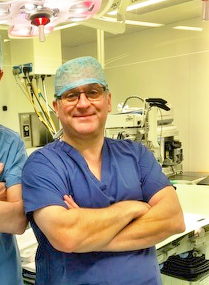Mind Your Step!
Leading foot and ankle surgeon, Mr Lloyd Williams, unravels the mystery of our feet, and explains how the condition of your feet can tell you a lot about the state of your general health.

Lloyd Williams, MB BS FRCS (Tr&Orth)
Mr R. Lloyd Williams is a Consultant Orthopaedic Surgeon Specialising in Foot and Ankle Disorders.
“Your feet are one of the most overworked, underappreciated, and undervalued body parts, and they deserve your attention!”

QUESTION: What is the pathway for a new patient in your clinic?
Mr Williams: If you come to see me with a foot or ankle problem, my job is to work out the best treatment approach by carefully evaluating your presenting condition.
I’ll first take a detailed case history and ask lots of questions about your condition, your musculoskeletal health, and general health, including a detailed discussion about the signs and symptoms you are experiencing and how your foot or ankle issue is affecting your daily life; a thorough medical examination follows this.
I have multiple years of treating every foot condition and that experience is invaluable in deciding the best treatment approach for a patient. I also work collaboratively with a multidisciplinary team of orthopaedic specialists to help formulate the most effective treatment plan to resolve your presenting condition effectively. This can range from minimally invasive surgery to non-surgical treatment, physical therapy, specialist rehabilitation, and providing ongoing patient support and advice throughout the treatment process.
Everyone at some stage in life will suffer from some annoying foot condition or problem; you may have something bothering you right now!

QUESTION: As a foot surgeon, do you only perform surgery?
Mr Williams: What should be emphasised is that there are many modalities of treatment that do not involve surgery. I do a lot of work that doesn’t involve surgery. Often, patients are misinformed about when it would be helpful to seek a specialist’s opinion on a foot or ankle problem. Many people think that you can only arrange a consultation with a foot specialist when there is the potential for having something that needs surgically fixing, but this is incorrect. Many of my patients come to see me for my expert advice with all sorts of debilitating and painful conditions for treatment that does not require surgery!
Examples of problems I would treat non-surgically are ankle sprains, Achilles tendonitis, plantar fasciitis, and many more. I would probably only operate on 1 in 3 patients I see.

QUESTION: Apart from the obvious, are there any other roles that feet play in our lives?
Mr Williams: Leonardo Da Vinci described the feet as “a masterpiece of engineering and a work of art, and he was right!
If you think about our feet mechanically, feet act as primary levers, which, at our will, propel us forward. They are a critical part of our body’s shock-absorbing system (along with our hips and knees), cushioning the effects of impact as they strike the ground as we walk and run.
Feet also act as a firm base of support while performing activities such as heavy lifting. They are critical in helping us position ourselves to minimise stress and strain on the rest of the musculoskeletal system.

QUESTION: What is the anatomy of the feet?
Mr Williams: Walking upright is a defining feature of humanity. The design of our feet is essential to how we walk upright and results from some rather impressive anatomy and biomechanics.
In the foot, there are 28 bones, 34 muscles, 33 major joints, 112 ligaments. The extrinsic muscles are the long muscles that come from the calf and shin, cross the ankle, and go down into the foot. The intrinsic muscles are the ones that arise from inside the foot itself, and they’re the much shorter muscles that are the meat of the foot – the small muscles in between the metatarsals. The Achilles tendon, which connects the muscles in your calf to your heel, is the strongest tendon in the body and is essential for walking and running. Also, there are multiple nerves, blood vessels, arteries, veins, skin and the toenails.

QUESTION: Tell us about some of the patients you have seen where feet are key to their profession.
Mr Williams: My specialist areas of work have been with rugby, football, and dance professionals. It’s true that for these professionals, their feet have to work harder and are put under more strain than most of us! During my career, I’ve been lucky enough to look after more than a few prima ballerinas en pointe! I’ve looked after professional dancers across all the ballet companies in London, namely the Royal Ballet, English National and the Central School, and also the Birmingham Royal ballet. For a dancer, the whole of the dancer’s body weight goes through the point of the ballet shoe at a pressure of twice a car tyre in lb/sq inch! So you can imagine there is a lot of stress on the foot bones. Dancers suffer with a range of foot problems, from stress fractures to posterior impingement where the dancer cannot get en pointe so does ‘cheating’ manoeuvres causing further foot problems. I recall in one week, I saw five dancers, but on average, I treat one dancer a week. What’s interesting is that broken bones are rare in dance. I have only seen one broken shin in a dancer – he fell off his bike!
I was lucky enough to work with Saracens Rugby Club when they were transitioning from amateur to professional sport, so there was a significant uptake in medical care. Common rugby injuries include broken ankles, ruptured Achilles tendons, and broken toes, which are rife in rugby! Some of these conditions can threaten a professional’s career, so the club must have a pastoral care approach, as well as medical care provision, as broken bones, often lead to arthritis in later life if not treated promptly and correctly.

QUESTION: How about the people who don’t use their feet in their profession? Do you see many problems with them?
Mr Williams: Of course, It’s not just professional feet that need looking after. Of the 10,000 + patients I have operated on, and the many more that I have offered non-surgical treatment and advice for, many of them are people who just need healthy functioning feet to live their lives comfortably and get them around in all that they want to do! So yes, I see all sorts of conditions for people who aren’t dancers and sports professionals ranging from arthroscopy – keyhole surgery within the ankle, carrying out an ankle replacement, bunion surgery, dealing with problems with the forefoot, the effects of arthritis, fractures, and the consequences of diabetes.
Between 75% and 80% of all people will suffer from a foot problem at some time in their lifetime, but most of us pay little attention to our feet, with just two in ten people considering their foot health regularly. It’s well worth keeping an eye on your feet as they can provide an early indication of a problem with your general health.

QUESTION: What are signs/symptoms related to your feet that you should get checked out?
Mr Williams: Symptoms such as reoccurring pain, numbness, tingling, and changes in the skin and nails of your toes, can often point to a systemic health condition; however, you can occasionally get any of these symptoms if you are standing or sitting for long periods. Keep an eye out if these persist, as conditions such as diabetes, nerve, and circulatory disorders often show up with initial symptoms like these in your feet. Other causes can include the effects of chemotherapy, alcohol abuse, leprosy, syphilis, and diabetes. Any persistent foot symptoms are worth getting checked out by your GP; you may need referring to a specialist for further investigation.
Get in contact with Mr Lloyd Williams
Mr Williams practices from the London Orthopaedic Clinic which is based at OneWelbeck Hospital in Marylebone.
A free talk by Mr Lloyd Williams at Lloyd’s
Reserve your place at Mr Williams’ live in-person, free lunchtime talk in the Lloyd’s Building on 28th March 2023 at 1:00 pm.


